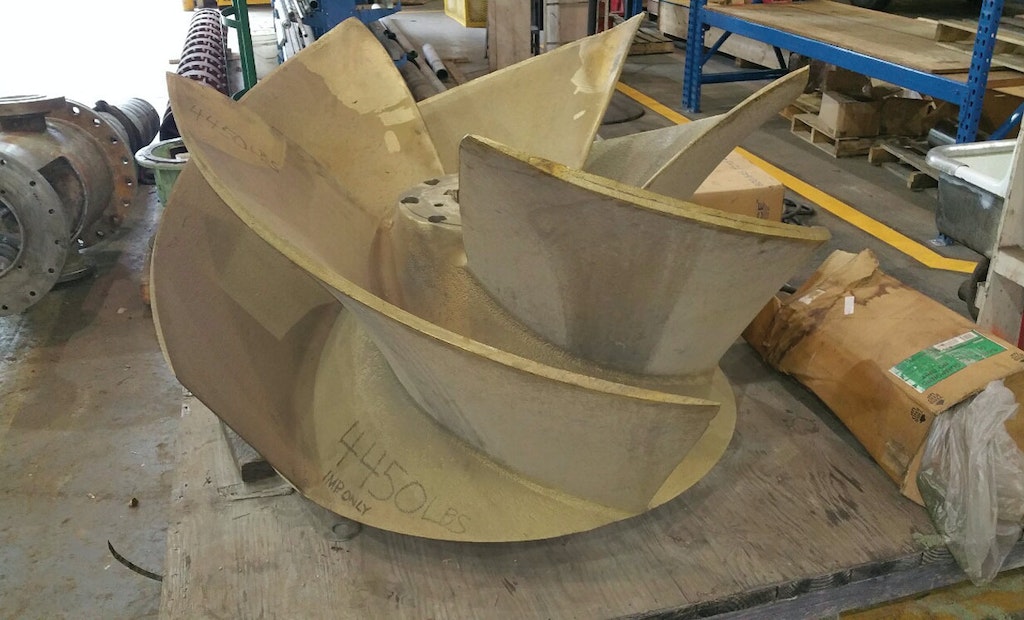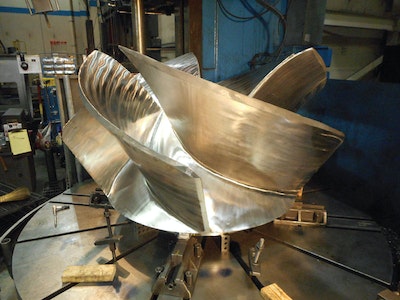
Interested in Blowers?
Get Blowers articles, news and videos right in your inbox! Sign up now.
Blowers + Get AlertsBig pumps at older water and wastewater treatment plants often show their age by way of lost efficiency and unreliability. Pumps perhaps 30 to 40 years and older may no longer be in production, and critical components may not be on the shelf at the manufacturer.
When that happens, there are options short of replacing the entire pump. One is to ask the manufacturer to fabricate a replacement part or engage a local machine shop to do the same. Another is to ask a third-party pump manufacturer to reverse engineer the part in question.
Reverse engineering can be an attractive option, especially given today’s manufacturing technology. Often, reverse engineering is faster and less costly than working with the original equipment manufacturer, which is likely focused on producing current pump models and cannot give priority to one-off fabrications.
Sulzer Pumps Solutions, a major pump manufacturer based in Switzerland, offers a dedicated reverse-engineering service. Jesse Jackson, a customer service manager, talked about the offering in an interview with Treatment Plant Operator.
TPO: What is the role of reverse engineering in pump operations?
Jackson: Large pumps are designed to perform for decades, requiring only periodic maintenance. But when the performance of an older pump begins to deteriorate, that may be a sign that the impeller is worn or the volute has become corroded. By the time this happens, finding new parts can be a considerable challenge. Access to spare parts becomes more and more difficult until the manufacturer has none available. In some cases, the company may have gone out of business. Fortunately, modern design techniques and manufacturing processes make it possible to create a vast range of components using reverse engineering.
TPO: What are the pros and cons of working with the original manufacturer of the pump to have a replacement component fabricated?
Jackson: In cases where the original equipment manufacturer is available, it may be possible to order new components, even if they have to be manufactured from the original drawings as a special build. The advantage here is the drawings, which provide all the necessary detail to create a new component.
The problem is usually the lead time. Most manufacturers’ fabrication facilities are dedicated to current pump models, and reassigning them to a one-off task may incur an additional delay. The second issue can be cost. OEM parts are unique to their products and manufactured to certain standards, so they carry a price premium. As the stock of spare parts for the older pumps diminishes, creating new parts has a higher cost threshold, and that can increase prices further.
TPO: How does reverse engineering differ from working with the OEM?
Jackson: Reverse engineering provides the capability to create a new component without drawings or reference material, which may not be available, especially if the OEM is no longer in business. In the past, reverse engineering has been a common practice for less intricate components, but the complex geometry of pumps has made this very difficult. Today, with sophisticated coordinate measuring machines, 3-D solid modeling software and laser scanning, it is possible to recreate not just simple parts, but also components with complex geometry.
TPO: Are there other potential advantages to reverse engineering?
Jackson: Yes. In addition to new manufacturing technology, there have been significant developments in materials. Older pumps are often created using materials that cannot be easily welded such as cast iron and bronze. In many cases, the original materials can be upgraded.
TPO: Why might an upgrade in materials be beneficial or necessary?
Jackson: Pumps, especially large ones, are often used in abrasive or corrosive conditions, and that can significantly reduce the expected operational life of components, such as the impeller. Upgrading the base material causes a relative increase in the initial repair cost, but the payoff is that it improves the pump service life and reduces the overall cost of ownership. The replacement of bronze with stainless steel is a common material upgrade.
TPO: Can the reverse-engineering process include making design improvements?
Jackson: Yes, it can. In addition to the materials used to create the pump, the detailed design can also be improved as part of the process. Since the original pump was installed, its purpose or its performance requirements may have changed, and that can be addressed in creating a reverse-engineered component. The hydraulic design is critical to the performance of the pump, and the latest design software and techniques such as computational fluid dynamics can be used to deliver the optimum design.
TPO: Outside of design, what other factors can make reverse engineering advantageous?
Jackson: Modern technology has improved manufacturing processes. For example, it is no longer necessary to build a wooden pattern for the part and ship it to the foundry for production of a casting. A computer model of the part can now be emailed. Foam cores and patterns can be made for one-off components, reducing both the time and cost to complete the process. In addition, 3-D printing can be used to create molds for smaller components, again speeding up the process to create replacement parts.
TPO: How much time does it take for delivery of a reverse-engineered replacement part from the time the customer orders it?
Jackson: That depends in part on the component’s size and complexity, but six weeks is a good rule of thumb. Delivering reverse-engineered projects takes time, but the process can be estimated accurately. This enables equipment owners to plan any process shutdowns and minimize the impact of the project. In some industries, a pump failure may have to be rectified with a temporary solution until a scheduled outage can occur, when the pump can be removed and repaired with a more robust solution. In such cases, the detailed measurements and modeling can be done during the initial repair process, allowing the new component to be manufactured before the scheduled outage to minimize downtime.
TPO: How would you characterize Sulzer Pumps Solutions’ qualifications to perform reverse engineering on pump components?
Jackson: Sulzer Pumps Solutions has adopted all of the technological advances in pump component manufacturing and has applied them to projects around the world. We are an independent service provider for repair and maintenance of rotating machines including turbomachinery, pumps and electromechanical equipment with a global network of 150 technically advanced manufacturing and test facilities. Our core aim is to deliver a flexible and cost-effective service that optimizes customers’ operational efficiency and minimizes downtime.






